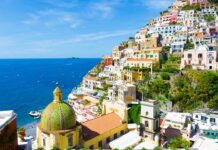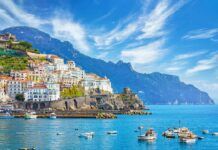From the top of the Lattari mountains, Ravello dominates the Amalfi Coast offering views of incomparable beauty. Its maze of narrow streets and villas overlooking the sea surrounded by lush gardens have made intellectuals and artists of all ages fall in love with it.
Ravello is located slightly inland, about 365 meters above sea level, between Minori and Amalfi, in a strategic position, which makes it perfect as a base for both sea excursions and trekking in the mountains, also giving views of unparalleled beauty. Precisely because of its slightly defiladed position, it has remained one of the most authentic locations on the coast. Its architectural beauties and its belvederes are truly breathtaking and over the centuries have enchanted visitors of all kinds and filled the hearts of many writers, composers and artists with passion.
Culture has always played a leading role in Ravello, which still attracts international jet-set personalities thanks to the Ravello Festival, one of the most important musical events in Italy, which usually takes place in July. The traditional location of the Festival is the splendid Villa Rufolo, one of the pearls of the place: built in Moorish style in the 13th century, from its terraced gardens facing east offers a breathtaking view of the entire Coast. This magical place bewitched, among others, the German composer Richard Wagner who drew inspiration here for his Parsifal, but also Boccaccio, who set one of his novels here. An equally amazing treasure of Ravello is Villa Cimbrone, with its lush vegetation and the famous Terrace of Infinity, outlined by a series of marble busts which stand out in an incredible chromatic contrast against the blue of the sky and the sea. Right here Virginia Woolf and other English intellectuals and artists, belonging to the famous Bloomsbury group, spent their summers in the early ‘900. Today the villa houses a luxury hotel, but the gardens are open to the public.
Noteworthy is also the Cathedral of Ravello, which dominates the central Piazza del Vescovado and welcomes visitors with its splendid portal with bronze bas-reliefs, made in 1179 in Constantinople and brought here by sea. Built in the 11th century in a mix of Baroque and Roman style, it is one of the oldest cathedrals in Italy and inside it holds the ampulla of the blood of St. Pantaleone, which just like that of St. Gennaro in Naples, seems to liquefy every year on July 27th. Finally, a bit of shopping: it is a pleasure to get lost in the narrow streets and alleys of Ravello and browse in the small craft stores looking for a souvenir to take home. Among the most sought after objects are the splendid ceramics, the true trademark of the coast, but also jewelry, especially coral, and obviously, the food and wine products of the territory.










